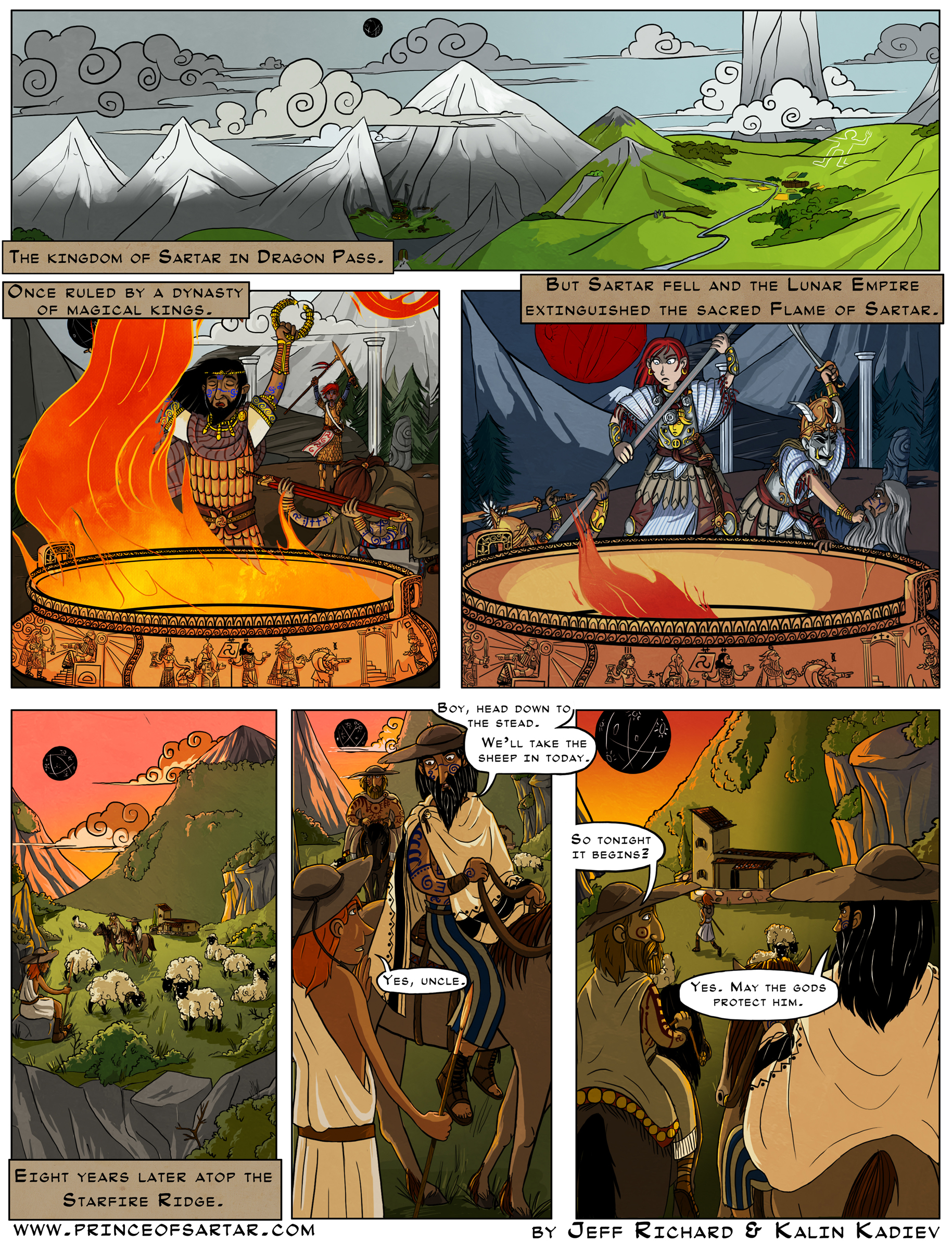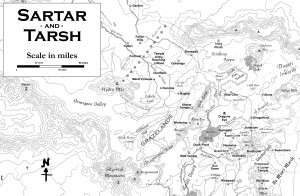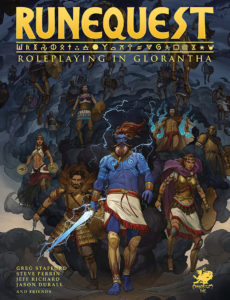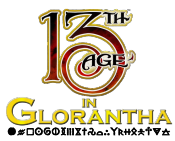1 – The Flame of Sartar
A Brief History
Glorantha was created by its deities from the Primal Void of Chaos. At first, there was no history, for the initial creation formed the period of magic and timeless simultaneity called God Time. During this time, the entire world was populated with the beings and races of the Golden Age.
The birth into this world of Umath, the Primal Air, shattered the period of peace with crowding, confusion and fear. This escalated into the Gods War, resulting in the death of the Sun, the Great Darkness, and Chaos let loose upon the world. Total Destruction seemed near.
But Glorantha was not destroyed. Spurred on by Hope and Chance, the Seven Lightbringers traveled through the Chaos-ridden Cosmos and, after harrowing adventures, liberated the life-giving Sun God. The joyful god leapt to his rightful place in the sky and the Dark was banished.
To keep entropic Chaos from coming to their realm again, the gods swore great oaths and compacts resulting in the Great Compromise. Men call this Time. By altering the world, the gods saved it, and history began.
There followed the Dawn Ages. This was a time of peace and growing, as the survivors rebuilt and taught themselves the way of the world inside Time. The ancient races, elves, dragonewts, dwarves, and trolls, were as healthy and proud as humans. In Dragon Pass, on the continent of Genertela, the First Council was a balanced organization including humans and non-humans, men and women, mortals and divinities.
This age of innocence could not last. Ancient feuds were remembered and conflicts grew with peoples outside the council. Inside dissension and outside enemies forced the formation of the Second Council, a warlike empire, which grew in arrogance and power until they dreamed of bringing back the God Time. The experiment ended in the birth of Gbaji the Chaos God, whose reign of terror kept Glorantha at war with itself for 75 years. This was the death knell of the inhuman races, which have never had the same stature in the world since then. This was the end of the Dawn Ages.
Out of this shattered world grew new political entities.
Among the most powerful was the state called the Empire of the Wyrms Friends. This empire, centered in Dragon Pass, lasted for 500 years, proud of and famous for their friendship with the dragons and wyrms of the pass. The peoples and places thrived, made contact with two other continents, and delved deep into spiritual byways.
After several hundred years the traditional rulers were replaced by a ruling body of men and gods called the Third Council. Legends relate that there was no telling the men from the gods in the council chambers.
But the magic of the council could not counter the miseries of its worshippers, or control the swords of the rebels who did not sacrifice to them. Foreign gods gained power and prestige as the provinces of the Third Council revolted or were overrun by invaders.
At last the council turned its energies to defending its worshippers. Epic battles raged across the land. Finally, the dragonewts, dormant for centuries, rose against the council and slew them all.
Some 78 years later, an alliance of human empires called the Invincible Gold Horde turned against the dragonewts. With few allies, the dragonewts seemed helpless before the destroying might of the Invincible Golden Horde. Dragonewt nests were scoured with wildfire, planted with seeds laid by Chaotic parasites, sealed by diseases unnamable, and cursed by fear and loathing for any that would mourn them.
Heartless and relentless, the humans crushed and plundered, but when they closed in upon Dragon Pass the assembled human armies met those who would mourn the loss of dragonewts. The dragons from all across Time and Space assembled in their ancestral home to preserve the purity of their birthplace. The Dragonkill War got its name from what the dragons did, not what they suffered. Humans have feared the dragons since that time, despite draconic indifference, and none now seek to smash the eggs of the dragonewts, even though they might plunder a nest city.
Dragon Pass was abandoned by humanity. Elsewhere, old empires shook and the seas were utterly closed to human crossing. New kingdoms rose to fill the power vacuums and new magics and deities broke free from ancient shackles.
Rise of the Lunar Empire
1220 years after the Dawn the Red Moon Goddess rose in the region called Peloria, to the north of Dragon Pass. In her were balanced Constancy and Change, Life and Death, Love and Indifference, and all the dichotomies of the Universe, including a touch of Chaos. Her arrival changed the face of the land.
After living in Glorantha a short time she ascended to the heavens where she remains in her cyclical beauty, viewing the land, which she left to her family below. The ever-reincarnating Red Emperor of the Lunar Empire is her son and her pride. The Lunar Empire expanded from its founding. When defeated it rebounded stronger than ever. They went north to the icy wastes, east to the bounds of the horse barbarian lands, and west until they were halted by the magical Syndics Ban. But in the south the empire continued to grow and grow.
When the empire reached Dragon Pass they found it populated again. Orlanthi refugees fleeing from the Lunar Empire had founded the Kingdom of Tarsh, while the southern and eastern reaches of Dragon Pass were settled by Orlanthi from the Holy Country. The Twins Dynasty of Tarsh dominated Dragon Pass and even retook land from the Lunar Empire until the kingdom was torn apart by civil war in 1448. In 1490, the Lunar demigoddess Hon-eel founded a Lunar Dynasty of Tarsh which ruled a rump of the kingdom from the new Lunar city of Furthest.
The House of Sartar
Leadership of Dragon Pass had passed to the Kingdom of Sartar, founded in 1492 by the hero Sartar, a magician and holy man who unified the quarreling tribes of that land without ever raising a weapon. The House of Sartar was a wise dynasty cautious to maintain the great and magical laws that gave it its strength. Sartar held off the Lunar Empire for more than a century.
Despite initial defeats, the Red Emperor eventually marched into the Sartar capital of Boldhome in 1602. He defiled the Temple of Sartar and ravaged the city. So far, it was the typical Lunar conquest.
But the remnants of the Household of Sartar incited the natives to rebel against the empire. The bravery and glory of Sartar’s fight for independence attracted thousands of volunteers, and people from all about Glorantha became adventurers in order to take their place in the ranks.
TEXT: The Kingdom of Sartar in Dragon Pass
DESCRIPTION: A daytime panorama of Dragon Pass. This is a mountainous country, with steep and jagged peaks. Heavy clouds hang in the sky. At the base of the mountains we can see the great city of Boldhome, the capital of Sartar. On the right, a river flows through an alpine valley. There is a settlement by the river, with a large chalk outline of a man on the hill above it. In the background is Mount Kero Fin, the tallest mountain in Dragon Pass, so tall that its peak cannot be seen in this picture. The ever-present Red Moon hangs in the sky behind the clouds.
Panel 2.
TEXT: Once ruled by a dynasty of magical kings.
DESCRIPTION: It is daytime. King Saronil of the Sartar Orlanthi leads a ritual in Boldhome. He is wearing kingly attire, his arms raised high, a golden torc in one hand. He is standing at the great bronze brazier that holds the magical Flame of Sartar, a great roaring flame. It is artfully decorated with scenes from Orlanthi mythology. A warrior kneels beside him, head bowed with a sword held out in supplication. Another warrior stands in the background, holding their spear and sword aloft in a similar manner to King Saronil.
Panel 3.
TEXT: But Sartar fell and the Lunar Empire extinguished the sacred Flame of Sartar.
DESCRIPTION: It is now night time. The Flame of Sartar is sputtering out, and there is now a crack in the bronze brazier. Two Orlanthi are being murdered behind it; one of them is a warrior, but the other is a defenceless scribe. Their killers are Lunars. One of them is a member of the masked elite soldiers of the Full Moon Corps. The other is Jar-Eel the Razoress, hero of the Lunar Empire. Her face is totally calm even as she impales the warrior. They wield spears and scimitars. The Red Moon looms in the background.
Panel 4.
TEXT: Eight years later atop the Starfire Ridge.
DESCRIPTION: Argrath watches a flock of sheep, sitting on a rock and holding a short bronze spear. He is a slender young man with angular features. His bare arms lack tattoos, showing that he is still a child in Orlanthi society. The sheep are grazing by the edge of a cliff. He is being approached by two farmers on horseback, one of them his uncle. In the distance is a large rustic house, an Orlanthi stead. The sun is setting behind a mountain.
Panel 5.
DESCRIPTION: Argrath looks up at his uncle. His uncle is an older man, bearded, with blue tattoos on his arms and torso. The other farmer is in the background. He is also tattooed, but his tattoos are maroon.
DIALOGUE:
Argrath's Uncle: Boy, head down to the stead. We'll take in the sheep today.
Argrath: Yes, uncle.
Panel 6.
DESCRIPTION: The two farmers watch as Argrath walks down to the stead.
DIALOGUE:
Orlanthi Farmer: So tonight it begins?
Argrath's Uncle: Yes. May the gods protect him.








I almost overlooked the cast of characters below the images.
JarEel has matured quickly from her leading the infant crusade that helped the Thawing of the Ban in the upper Janube valley, IIRC only 4 years earlier than the Fall of Boldhome, as nothing more than a toddler. I think she might be a year or two younger than Argrath.
Didn’t we once work out that she was chronologically 14 at the fall of Boldhome? Given her lineage, though, I expect she did mature miraculously fast.
Hey, you folks should add comic navigation buttons to the bottom of the comic as well – if I’m done reading a page, it’s annoying to have to scroll back up past it if I want to read the next strip.
Good point. I have added it below the comments as well.
I like the Cerne Abbas look-a-like (minus the ‘extra’ appendage!). Perhaps something similar to a White Horse figure might be appropriate too?
That is Chalk Man, an earth Spirit that really has no place being there, but I had forgotten to check where he’s actually located. So now he’s near the Quivin Mountains.
Kalin: THANK YOU SO MUCH FOR THIS!!! This is awesome! I hope to see hundreds of pages more like these!
Keep up the good job!
Thank you for the kind words, Runeblogger! I am glad you’re enjoying the comic.
HAIL ORLANTH. I’m actually posting links to this in Chaos Magick groups as examples of modern mythology and it’s use in personal transformation.
Paul Reilly. Hail Sedenya! I think Jar Eel has Centuries, Millenia, or /more/ of illusionary experiences as she is growing up, carefullly planned for decades at least in many cases.